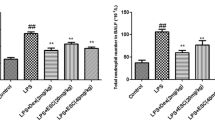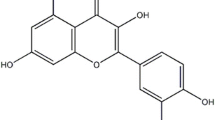Abstract
Remifentanil significantly represses cell immune responses and influences neutrophil migration through endothelial cell monolayers. The present study determines the beneficial effects of remifentanil and the mechanisms by which it attenuates lipopolysaccharide (LPS)-induced acute lung injury (ALI). Rats were intratracheally instilled with 2 mg/kg LPS to induce ALI. Results showed that remifentanil could resolve lung injury, as evidenced by remarkable decreases in lung edema (wet-to-dry weight ratio), neutrophil infiltration (myeloperoxidase activity), and pulmonary permeability [total number of cells and protein concentrations in bronchoalveolar lavage fluid (BALF)]. Remifentanil also attenuated the concentrations of proinflammatory cytokines tumor necrosis factor alpha, interleukin-1β, and interleukin-6 in BALF, as well as effectively repressed the activation of nuclear factor-kappaB (NF-κB), which has been associated with the inhibition of IκBα degradation.These results suggest that remifentanil may be a suitable treatment for LPS-induced ALI. Remifentanil exerts beneficial effects on the inhibition of proinflammatory cytokine production by downregulating the NF-κB pathway.





Similar content being viewed by others
References
Ware, L.B., and M.A. Matthay. 2000. The acute respiratory distress syndrome. New England Journal of Medicine 342: 1334–1349.
Brigham, K.L., and B. Meyrick. 1986. Endotoxin and lung injury. American Review of Respiratory Diseases 133: 913–927.
Matute-Bello, G., C.W. Frevert, and T.R. Martin. 2008. Animal models of acute lung injury. American Journal of Physiology-Lung Cellular and Molecular Physiology 295: L379–L399.
Li, G., J. Li, Q. Zhou, X. Song, H. Liang, and L. Huang. 2010. Growth hormone releasing peptide-2, a ghrelin agonist, attenuates lipopolysaccharide-induced acute lung injury in rats. Tohoku Journal of Experimental Medicine 222: 7–13.
Xu, C.Q., B.J. Liu, J.F. Wu, Y.C. Xu, X.H. Duan, Y.X. Cao, and J.C. Dong. 2010. Icariin attenuates LPS-induced acute inflammatory responses: Involvement of PI3K/Akt and NF-kappaB signaling pathway. European Journal of Pharmacology 642: 146–153.
Kwak, J.H., S.W. Won, T.J. Kim, E. Roh, H.Y. Kang, H.W. Lee, J.K. Jung, B.Y. Hwang, Y. Kim, J. Cho, and H. Lee. 2008. Synthesis of chroman-2-carboxylic acid N-(substituted)phenylamides and their inhibitory effect on nuclear factor-kappaB (NF-kappaB) activation. Archives of Pharmacal Research 31: 133–141.
Mason, P. 2002. Remifentanil. Intensive Critical Care Nurse 18: 355–357.
Zongze, Z., Z. Jia, C. Chang, C. Kai, and W. Yanlin. 2010. Protective effects of remifentanil on septic mice. Molecular Biology Reports 37: 2803–2808.
Sacerdote, P., L. Gaspani, G. Rossoni, A.E. Panerai, and M. Bianchi. 2001. Effect of the opioid remifentanil on cellular immune response in the rat. International Immunopharmacology 1: 713–719.
Hofbauer, R., M. Frass, B. Gmeiner, N. Sandor, R. Schumann, O. Wagner, and A.D. Kaye. 2000. Effects of remifentanil on neutrophil adhesion, transmigration, and intercellular adhesion molecule expression. Acta Anaesthesiologica Scandinavica 44: 1232–1237.
Hartree, E.F. 1972. Determination of protein: A modification of the Lowry method that gives a linear photometric response. Analytical Biochemistry 48: 422–427.
Song, X.M., J.G. Li, Y.L. Wang, Z.F. Hu, Q. Zhou, Z.H. Du, and B.H. Jia. 2008. The protective effect of the cholinergic anti-inflammatory pathway against septic shock in rats. Shock 30: 468–472.
Andrews, N.C., and D.V. Faller. 1991. A rapid micropreparation technique for extraction of DNA-binding proteins from limiting numbers of mammalian cells. Nucleic Acids Research 19: 2499.
Kwak, S.H., J.I. Choi, and J.T. Park. 2004. Effects of propofol on endotoxin-induced acute lung injury in rabbit. Journal of Korean Medical Science 19: 55–61.
Lin, Y., X. Zhu, W.Z. Yao, Y.L. Yang, L. T. A., and L. Chen. 2011. Yohimbine protects against endotoxin-induced acute lung injury by blockade of alpha 2A adrenergic receptor in rats. Chinese Medical Journal (English) 124: 1069–1074.
Goodman, R.B., J. Pugin, J.S. Lee, and M.A. Matthay. 2003. Cytokine-mediated inflammation in acute lung injury. Cytokine & Growth Factor Reviews 14: 523–535.
Minamino, T., and I. Komuro. 2006. Regeneration of the endothelium as a novel therapeutic strategy for acute lung injury. Journal of Clinical Investigation 116: 2316–2319.
Matthay, M.A., and G.A. Zimmerman. 2005. Acute lung injury and the acute respiratory distress syndrome: Four decades of inquiry into pathogenesis and rational management. American Journal of Respiratory Cell and Molecular Biology 33: 319–327.
Paladino, J.D., J.R. Hotchkiss, and H. Rabb. 2009. Acute kidney injury and lung dysfunction: A paradigm for remote organ effects of kidney disease? Microvascular Research 77: 8–12.
Hopkins, S.J. 2003. The pathophysiological role of cytokines. Legal Medicine (Tokyo) 1: S45–S57. 5 Suppl.
Ke, J.J., J. Zhan, X.B. Feng, Y. Wu, Y. Rao, and Y.L. Wang. 2008. A comparison of the effect of total intravenous anaesthesia with propofol and remifentanil and inhalational anaesthesia with isoflurane on the release of pro- and anti-inflammatory cytokines in patients undergoing open cholecystectomy. Anaesthesia and Intensive Care 36: 74–78.
Fan, J., R.D. Ye, and A.B. Malik. 2001. Transcriptional mechanisms of acute lung injury. American Journal of Physiology-Lung Cellular and Molecular Physiology 281: L1037–L1050.
Schwartz, M.D., E.E. Moore, F.A. Moore, R. Shenkar, P. Moine, J.B. Haenel, and E. Abraham. 1996. Nuclear factor-kappa B is activated in alveolar macrophages from patients with acute respiratory distress syndrome. Critical Care Medicine 24: 1285–1292.
Blackwell, T.S., T.R. Blackwell, E.P. Holden, B.W. Christman, and J.W. Christman. 1996. In vivo antioxidant treatment suppresses nuclear factor-kappa B activation and neutrophilic lung inflammation. Journal of Immunology 157: 1630–1637.
Liu, S.F., X. Ye, and A.B. Malik. 1997. In vivo inhibition of nuclear factor-kappa B activation prevents inducible nitric oxide synthase expression and systemic hypotension in a rat model of septic shock. Journal of Immunology 159: 3976–3983.
Abraham, E., A. Carmody, R. Shenkar, and J. Arcaroli. 2000. Neutrophils as early immunologic effectors in hemorrhage- or endotoxemia-induced acute lung injury. American Journal of Physiology-Lung Cellular and Molecular Physiology 279: L1137–L1145.
Acknowledgments
This work was financially supported by the National Natural Science Foundation of China (no. 30972852).
Author information
Authors and Affiliations
Corresponding author
Rights and permissions
About this article
Cite this article
Zhang, Y., Du, Z., Zhou, Q. et al. Remifentanil Attenuates Lipopolysaccharide-Induced Acute Lung Injury by Downregulating the NF-κB Signaling Pathway. Inflammation 37, 1654–1660 (2014). https://doi.org/10.1007/s10753-014-9893-2
Published:
Issue Date:
DOI: https://doi.org/10.1007/s10753-014-9893-2




